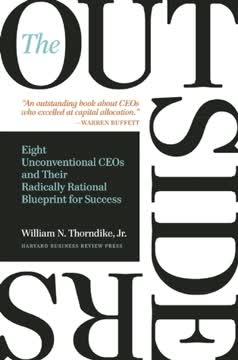つの重要なポイント
1. 価値投資:割安証券を購入する技術
価値投資は理解するのは簡単だが、実行するのは難しい。
基本原則。 価値投資は、証券をその基礎価値から大幅に割引された価格で購入することを含む。このアプローチには、ビジネスの基本を深く理解し、市場で誤価格された資産を特定する能力が必要である。
主要な要素:
- 財務諸表の徹底的な分析
- 競争優位性と業界動向の評価
- 適切な機会を待つ忍耐力
- 資産に対して過剰に支払わない規律
価値投資家は短期的な市場の変動ではなく、長期的なリターンに焦点を当てる。彼らは強固な基礎、安定したキャッシュフロー、そして有能な経営陣を持つビジネスを求める。割安証券を購入することで、価値投資家は潜在的な下振れリスクから投資を保護する安全マージンを作り出す。
2. 機関投資の落とし穴とウォール街の短期志向
ほとんどの機関投資家は短期的な相対的パフォーマンス志向に悩まされており、退職金や基金が必要とする長期的な視点を欠いている。
機関の制約。 多くのプロの投資家は、四半期ごとや年次ごとにベンチマークや同業者を上回るよう圧力を受ける。この短期志向はしばしば最適でない投資判断を招き、長期的な価値機会を逃す原因となる。
ウォール街の偏見:
- 四半期ごとの収益と短期的な価格変動への強調
- 群衆に従い、人気のトレンドを追う傾向
- 投資銀行とそのクライアント間の利益相反
- 単純な評価指標や財務モデルへの過度の依存
個人投資家は、長期的な視点を採用し、短期的な市場のノイズではなく基本的な分析に焦点を当てることで優位性を得ることができる。機関投資の落とし穴を避けることで、価値投資家は他の人が見逃したり誤解したりする機会を見つけることができる。
3. 安全マージン:リスク回避型投資の礎
価値投資家になるためには、基礎価値から割引された価格で購入しなければならない。これにより、絶対的な価値が得られる。
リスク軽減。 安全マージンは、証券の価格とその推定内在価値の差である。資産をその真の価値よりも大幅に割引された価格で購入することで、投資家は潜在的な損失に対するバッファを作り、優れたリターンを達成する可能性を高める。
安全マージンの利点:
- 評価の誤りや予期せぬ出来事に対する保護
- 資本増価の可能性の増加
- 市場の下落時の下振れリスクの軽減
- 長期間にわたって投資を保持する柔軟性の向上
安全マージンの大きさは、投資のリスクの認識に比例するべきである。リスクの高い機会にはより大きな安全マージンが必要であり、より安定した投資には内在価値に対する小さな割引が適している。
4. ビジネス評価:価値投資家にとっての重要なスキル
ビジネスの価値は正確に決定することはできない。
評価方法。 投資家は、ビジネスの内在価値を推定するためにさまざまな技術を使用し、評価が正確な科学ではなく不正確な芸術であることを認識する必要がある。
主要な評価アプローチ:
- 割引キャッシュフロー分析
- 比較会社分析
- 資産ベースの評価
- 清算価値の評価
成功した価値投資家は、ビジネス評価の定量的および定性的な要素を考慮し、評価方法の限界を認識し、複数のアプローチを使用して内在価値の合理的な推定を行う。保守的な推定に焦点を当て、安全マージンを維持することで、投資家はビジネス評価の不確実性を軽減することができる。
5. 市場の非効率性における価値機会の特定
良い投資アイデアは希少で価値のあるものであり、熱心に探し出さなければならない。
市場の異常。 価値投資家は、市場で見過ごされ、誤解され、一時的に不人気な領域で機会を探す。これらの非効率性は、機関の制約、投資家の心理、または詳細な分析を必要とする複雑な状況によってしばしば生じる。
価値機会の潜在的な源:
- スピンオフや企業再編
- 財政的に困窮した証券
- 小型株およびマイクロキャップ株
- 特殊な状況(例:合併裁定、清算)
特定のニッチでの専門知識を深め、反対の考え方を維持することで、価値投資家は他の人が見逃す機会を特定することができる。このアプローチには、綿密な調査、忍耐力、そして潜在的な報酬がリスクに見合う場合に従来の知恵に逆らう意欲が必要である。
6. 投資価値を実現するためのカタリストの力
内在価値の実現のためのカタリストはリスクを軽減する役割を果たす。
価値実現。 カタリストは、証券の市場価格とその内在価値のギャップを埋めるのに役立つ出来事や状況である。潜在的なカタリストを特定することで、投資家は成功の可能性を高め、投資仮説が実現するまでの時間を短縮することができる。
カタリストの種類:
- 企業行動(例:自社株買い、資産売却)
- 経営陣や所有権の変更
- 業界の統合や規制の変更
- ビジネスパフォーマンスや市場状況の改善
投資家は、複数の潜在的なカタリストが存在する機会を探すべきであり、これにより価値実現の可能性が高まる。しかし、カタリストが実現しない可能性があるため、忍耐強く待ち、過度な売買やポートフォリオの回転を避けることが重要である。
7. 財政的に困窮した証券への投資:高リスク・高リターン
財政的に困窮した証券や破産証券への投資には、適切な状況と適切な証券を適切な価格で待つ忍耐力と、価値投資の基準を守る規律が必要である。
危機における機会。 困窮した証券は、投資家の恐怖、強制売却、複雑な状況により、その潜在価値に対して大幅に割引されて取引されることが多い。これにより、これらの挑戦的な投資をナビゲートする専門知識とリスク許容度を持つ投資家にとって機会が生まれる。
困窮投資の主要な考慮事項:
- 資本構造と債権者の優先順位の徹底的な分析
- 回収シナリオの評価
- 破産および再編プロセスの理解
- ビジネスを立て直す経営陣の能力の評価
困窮投資は大きなリターンを提供する可能性があるが、同時に大きなリスクも伴う。投資家は潜在的な損失に備え、再編プロセスが進行するのを待つ忍耐力を持つ必要がある。ポートフォリオ全体のリスクを管理するために、分散投資とポジションサイズの調整が重要である。
8. ポートフォリオ管理:リスクとリターンのバランス
ポートフォリオ管理は、投資家にとってリスクを軽減するためのさらなる手段である。
リスク管理。 効果的なポートフォリオ管理は、個々の投資を選択するだけでなく、ポートフォリオ全体でリスクとリターンのバランスを取るための包括的なアプローチを必要とする。
ポートフォリオ管理の主要な側面:
- セクターや資産クラス全体での適切な分散
- ポジションの監視とリバランス
- ポートフォリオの流動性とキャッシュフローの管理
- 適切な場合のヘッジ戦略の実施
投資家は、最良のアイデアを希釈せずに特定リスクを軽減するレベルの分散を目指すべきである。バランスの取れたポートフォリオを維持し、リスクエクスポージャーを積極的に管理することで、投資家は全体的なリスク調整後のリターンを向上させ、新たな機会が生じたときにそれを活用する能力を高めることができる。
9. 価値投資における忍耐と規律の重要性
投資家は保守的な予測を行い、それに基づいて大幅に割引された価格でのみ投資することが賢明である。
長期的な焦点。 価値投資で成功するためには、真に魅力的な機会を待つ忍耐力と、厳格な投資プロセスを守る規律が必要であり、これには市場の一般的な感情に逆らうことも含まれる。
成功した価値投資家の主要な属性:
- 魅力的な機会が少ないときに現金を保持する意欲
- 短期的なパフォーマンスの低下に耐える能力
- 投資スキルの継続的な学習と洗練
- 市場の変動に対する感情のコントロール
長期的な視点を維持し、投資の基本に焦点を当てることで、価値投資家は短期的な思考や感情的な意思決定の落とし穴を避けることができる。このアプローチにより、市場の非効率性を活用し、時間をかけて優れたリスク調整後のリターンを達成することができる。
最終更新日:
FAQ
What's Margin of Safety about?
- Value Investing Focus: Margin of Safety by Seth A. Klarman centers on risk-averse value investing strategies, advocating for buying securities at a discount to their intrinsic value.
- Avoiding Pitfalls: It highlights common investor mistakes like speculation and emotional trading, offering strategies to avoid these traps.
- Long-Term Success: The book promotes a disciplined, long-term approach to investing, prioritizing sustainable success over short-term gains.
Why should I read Margin of Safety?
- Expert Insights: Klarman, a renowned investor, shares invaluable insights into value investing, beneficial for both novices and seasoned investors.
- Timeless Principles: The principles are applicable across various market conditions, making the book relevant regardless of current trends.
- Capital Preservation: Emphasizes the importance of preserving capital and avoiding losses, crucial for long-term investment success.
What are the key takeaways of Margin of Safety?
- Margin of Safety Concept: Klarman stresses buying securities below intrinsic value to protect against judgment errors.
- Investing vs. Speculation: Differentiates investing, based on fundamentals, from speculation driven by trends and emotions.
- Discipline and Patience: Successful investing requires waiting for the right opportunities and holding investments until value is realized.
What is the concept of "margin of safety" in Margin of Safety?
- Definition: It's the difference between a security's intrinsic value and its market price, central to value investing.
- Risk Mitigation: Provides a buffer against errors and unforeseen market events, reducing the likelihood of permanent capital loss.
- Practical Application: Involves calculating intrinsic value and identifying securities trading below this value, requiring disciplined analysis.
How does Seth A. Klarman define value investing in Margin of Safety?
- Buying at a Discount: Value investing involves purchasing securities at a significant discount from their intrinsic value to minimize risk.
- Focus on Fundamentals: Requires thorough analysis of a company's fundamentals to determine its true worth, avoiding reliance on market trends.
- Long-Term Perspective: Emphasizes a long-term view, as market recognition of undervalued securities may take time.
What are the common pitfalls investors face according to Margin of Safety?
- Speculation vs. Investment: Confusing speculation with investment leads to poor decisions based on short-term movements.
- Emotional Trading: Emotions like greed and fear can cloud judgment, causing irrational decisions and losses.
- Ignoring Fundamentals: Overlooking business fundamentals in favor of price movements can result in significant financial mistakes.
How does Klarman suggest investors should approach risk in Margin of Safety?
- Avoiding Loss is Key: The primary goal should be avoiding losses, not just achieving high returns, crucial for long-term success.
- Assessing Risk vs. Return: Evaluate risk independently from potential return, ensuring expected return justifies the risk.
- Margin of Safety: Investing with a margin of safety protects against market fluctuations and judgment errors.
How does Margin of Safety address the concept of risk?
- Comprehensive Risk Assessment: Risk should be assessed considering both market volatility and business fundamentals, beyond traditional metrics like beta.
- Permanent Loss Focus: Emphasizes focusing on the risk of permanent loss rather than short-term price fluctuations.
- Investor Behavior: Discusses how behavior influences risk perception, encouraging rational and disciplined responses to market movements.
What are the best quotes from Margin of Safety and what do they mean?
- "Avoid losing money": Capital preservation is paramount, reminding investors that protecting assets is as important as making money.
- "Expect price fluctuations": Investors should tolerate volatility, understanding it's crucial for long-term success.
- "Sell when you want": Highlights the importance of liquidity and flexibility, allowing strategic decisions rather than forced actions.
How does Klarman view market volatility in Margin of Safety?
- Volatility as Opportunity: Sees market volatility as a chance to acquire undervalued securities due to irrational reactions.
- Temporary vs. Permanent Loss: Distinguishes between temporary price changes and permanent value loss, focusing on the latter.
- Expecting Fluctuations: Advises investors to be prepared for price fluctuations, reconsidering strategies if volatility is intolerable.
What strategies does Klarman recommend for finding attractive investments in Margin of Safety?
- Bottom-Up Approach: Focus on individual securities through thorough fundamental analysis, rather than macroeconomic trends.
- Catalysts for Value Realization: Look for triggers like corporate actions or market changes that can realize underlying value.
- Market Inefficiencies: Seek out mispriced securities due to irrational behavior or lack of information, uncovering hidden market opportunities.
How does Klarman suggest managing a portfolio in Margin of Safety?
- Diversification Importance: Mitigate risk with a well-diversified portfolio, holding a manageable number of securities for deep understanding.
- Liquidity Management: Maintain liquidity to seize new opportunities, balancing liquid and illiquid investments for optimal returns.
- Regular Review: Regularly review and rebalance the portfolio to align with investment goals and adjust to market conditions.
レビュー
『Margin of Safety』は、現代のバリュー投資の古典として高く評価されているが、時代遅れと感じる人もいる。読者は、クラーマンのバリュー投資の原則の明確な説明、リスク管理の重要性の強調、市場の非効率性に関する洞察を称賛している。多くの人は、その簡潔でわかりやすい文章のために、グレアムの『賢明なる投資家』よりも優れていると考えている。批評家は、いくつかの時代遅れの例や特定の推奨事項に異議を唱えている。絶版にもかかわらず、投資家たちは資本を守ることに焦点を当てた、規律ある逆張り投資に関する時代を超えた知恵を求めてこの本を探し求めている。
Similar Books














